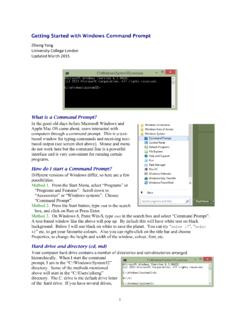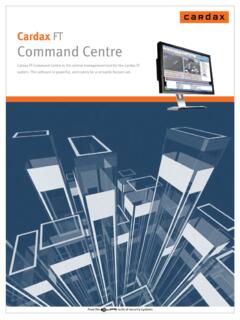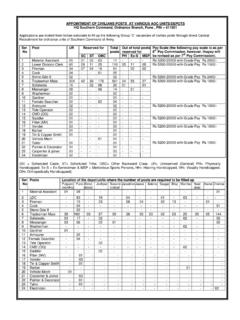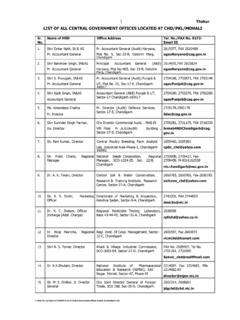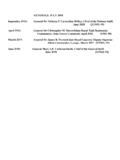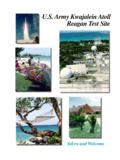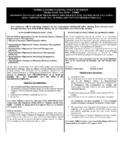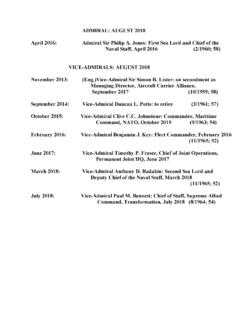Transcription of Unix Basics - UCL
1 unix BasicsHistoryThe first version of unix was developed by Bell Labs (part of AT&T) in 1969, making it more than forty years old and one of the few cases of a computer technology that has survived more than a decade. Its roots go back to when computers were large and rare, time on them very expensive and shared between many users unix was designed from the beginning1 to have multiple users working simultaneously. While this might seem strange and unnecessary in a world where everyone has their own laptop, computing is again moving back to remote central services with many users: the compute power required for mapping next-generation sequencing data or de novo assembly is beyond what is available or desirable to have sitting on your lap. In many ways, the Cloud (or what ever has replaced it by the time you read this) requires ways of working that are more in common with traditional unix machines than the personal computing emphasised by Windows and Apple federal monopoly law prevented AT&T from commercialising unix but interest in using it increased outside of Bell Labs and eventually they decided to give it away freely, including the source code, which allowed other institutions to modify it.
2 Perhaps the most important of these institutions was the University of Berkeley2 which distributed a set of tools to make unix more useful and made changes that significantly increased performance. The involvement of several universities in its development meant unix was ideally placed when the internet was created and many of the fundamental technologies were developed and tested using unix machines. Again these improvements were given away freely, some of the code being repurposed to provided networking for early versions of Windows and even today several utilities in Windows Vista incorporate Berkeley code3. As well as being a key part in the development of the early internet, a unix machine was also the first web server, a NeXT cube4. NeXT was an early attempt to make a unix machine for desktop use, extremely advanced for its time but also very expensive so they never really caught on outside of the finance industry.
3 Apple eventually bought NeXT, its operating system becoming OsX, and this heritage can still be seen in its programming interfaces. Apple is now the largest manufacturer of unix machines; every Apple computer, the iPhone and most recent iPods have a unix base underneath their the early 90s unix became increasingly commercially important which inevitably lead to legal trouble: with so many people giving away improvements freely and having them integrated into the system, who actually owned it? The legal trouble cast uncertainty over the freely available unix versions, creating an opening for another free operating vacuum was filled by Linux, a freely available computer operating system5 similar to unix and 1 This is lie. In truth, unix actually grew out of a desire to play a game called Space Travel (video_game) and the features that made it an operating system were incidental. Initially it only supported one user and the name unix , originally UNICS, is an unfortunate pun on MULTICS, a multi-user system available at the significant proportion of Mac OsX has its roots in the Berkeley Standard Distribution (BSD).
4 3 For example: strings | grep Cal @(#) Copyright (c) 1983 The Regents of the University of correctly, Linux is just the kernel, the central program from which all others are run. Many more tools in addition to this are required to make an operating system, tools provided by the GNU project. by Linus Torvalds in 1991 as a hobby. Importantly, Linux was written from scratch and did not contain any of the original unix code and so was free of legal doubt. Coinciding with the penetration of the internet onto university campus and the availability of cheap but sufficiently powerful personal computers, Linux rapidly matured with over one hundred developers collaborating over the internet within two years. The real advances driving Linux were social rather than technological, disparate volunteers donating time on the understanding that, in return for giving their work away freely, anything based on their work is also given away freely and so they in turn benefit from improvements.
5 The idea that underpins this sharing and ensures that nobody can profit from anyone else's work without sharing is copyleft , described in a simple legal document called the GNU General Public Licence which turns the notion of copyright on its , Linux has become the dominant free unix -like operating system with millions of users and support from many large and installing UbuntuThis tutorial concentrates on the Ubuntu distribution (packaging) of Linux, which is one of the most widely used, but all the examples are fairly generic and should work with most Linux, unix and Macintosh computers. There are many different guides on the web about how to install Ubuntu but we recommend installing it as a virtual machine on your current computer, see separate documentation for Ubuntu Linux distribution is generally easy to use and it is updated (for free) every six months. At the time of writing, the current version of Ubuntu is , named after its release date in October 2011, and also known as Oneiric Ocelot ; the next version, or Precise Pangolin will be released in April 2012 and will be designated a Long Term Support (LTS) edition, meaning that it will be receive fixes and maintenance upgrades for five years before being retired, and is the best option if you don't want to be regularly upgrading your significant effort has been undertaken to make Ubuntu easy to use, so even novice computer users should have little trouble using it.
6 There is a considerable number of tutorials available for users new to Ubuntu; the official material is available at but a quick search on the web will locate much more. In addition, there is a lot of documentation installed on the machine itself: you can access this by moving the mouse towards Ubuntu Desktop at the top left of the screen and clicking on the help menu that appears. In general, the name of the program you are currently using is displayed at the top-left of the screen and moving the mouse to top of the screen will reveal the programs menus in a similar fashion to how they are displayed on the Mac (although, confusingly, some programs display their menus within their own window rather like a Windows computer).An alternative way to get help is to click on the circular symbol (a stylised picture of three people holding hands) at the top left of the screen and type help in the search box that appears.
7 For want of a better name, we will refer to the people-holding-hands button as the Ubuntu button although the help text that appears describes it as Dash home .Ubuntu comes free with many tools, including web browsers, file managers, word processors, etc. Generally there is a free equivalent for most software you might use and you can browse those available by clicking on the Ubuntu Software Centre, whose icon at the left of the screen looks like a 6It should be noted that the GNU project, and the philosophy behind it, predate Linux by almost a bag full of goodies. The Ubuntu Software Centre is just a starting point and there are many other sources available, both of prepackage software specifically for Ubuntu and source code that will require compiling. Search the web for Ubuntu software repositories for more information on obtaining additional there are explicit key combinations for copy and pasting text, just like on Windows or Mac, shift-control-c and shift-control-v in Ubuntu, this convention is not respected by all programs.
8 unix has traditionally been more mouse centred with the left mouse button used to highlight text and the middle button used to copy it. You may find yourself accidentally doing this occasionally if you aren't used to using the middle mouse applications from icons, opening folders, only requires a single click, rather than the double click required on Windows, making the action of pressing buttons and selecting things from menus more consistent with each other. Accidentally double clicking will generally result in an action being done twice, not normally a bad thing but it does means that impatient users can quickly find their desktop covered in the most important difference you are likely to encounter on a daily basis is that the names of files and directories are case sensitive: , and all refer to different files. This is different from both Windows and Mac OsX7, where upper and lower-case characters are preserved in the name but the file can be referred to using any case.
9 Fetching the examplesThere are many examples in this tutorial to be tried, enclosed in boxes like the one below which explains the format of the examples. The files required for the examples can be downloaded from although the example below shows how to automatically download and unpack the file ready for use.#Ordinary text, starting with a # and indented on the first line, is a comment #on the text is something to type in at the command-line. A single line wrapped on to multiple lines is indicated by the ' ' symbolThis is now a separate text is a reply from the computer to what was typed in#Now we will download and install the examples#Firstly, ensure that we are in the home directorycd#Where an example requires you to be in a specific directory, it will start#with the command and reply to tell you where you should be. If you are not# in the correct directory, move to it before doing the example (see later for#how to change directory.)
10 Here 'ebi' is just the name of the user (you), #yours may #Download and unpack the examples. You don't need to understand what this is#doing yet, although you will by the time you have worked through this # -O - ' ' | tar -zx#If you are trying the examples out on a Mac, the command wget is not 7 Despite its unix heritage. This behaviour is deliberate to maintain compatibility with earlier versions of the Mac operating system.#available and the above will not work. Instead, use the similar curl commandcurl -L ' ' | tar -zx#A directory `examples' should have been examples/unixCompressionLineEndingsMulti pleFilesSCPhaikuEscapingMoveCopyPipesScr ipting#How to delete the examples, if required#Firstly, ensure that we are in the home directory (where the examples where #installed).cdrm -rf examplesThe command lineWhile Ubuntu has all the graphical tools you might expect in a modern operating system, so new users rarely need to deal with its unix foundations, we will be working with the command-line.
